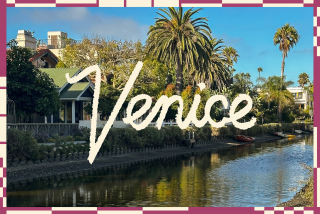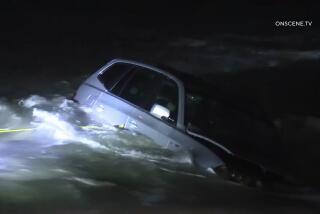Along the Canals, Summer Party Never Ends
- Share via
Even past combatants admit that the water fights of Naples got out of hand. Boaters cruised the canals and hurled water balloons onto the patio parties above them. Partygoers retaliated with garden hoses.
“Kids would go up on the bridges and dump buckets of water down on unsuspecting boaters,” said Dr. Rick Adams, a physician in his 40s who used to take part.
By nightfall, revelers would quaff enough beer, wine and margaritas to sink a cargo ship. Fun? Like a pillow fight while your parents are sleeping. Like sneaking out the window to go dancing. Fun hardly began to describe it, unless you showed up unprepared to get wet. Which was, said Adams, part of the problem: “Not everyone knew about the tradition of water fights on the Fourth of July.”
A crackdown by patrol boats has muted the water wars on the Naples canals, but the canal people still manage to enjoy life pretty much all year-round. Like some chosen tribe, immune from the urban woes of greater Los Angeles, these Long Beach residents are blessed with money and--imagine it--good times too.
They are forever holding kayak races, swim races and regattas. They run their skiffs up and down Alamitos Bay and take their yachts to Newport Beach and Santa Catalina Island.
Any time the weather is nice--and mostly it is--they fill the weekends with cocktail parties and cookouts on the brick patios lining the canals. Some begin on sunlit afternoons, with breezes pushing at the weather vanes, and end at night with flames leaping from the fire pits.
At Christmas, the homes are festooned with so many lights the canals almost shimmer. Thousands of people come down to stroll the waterways. The annual boat parade consists of craft small enough to fit under the canal bridges: electric boats, dinghies, kayaks and ski boats, all strung with lights. Miniature barges carry high school bands.
The Neptunes, a group of free-divers, slip into wetsuits and endure the chilly waters to push around a segmented dragon: a Loch Ness-like monster that spouts flames from its butane-fed mouth. The divers number from two dozen to four dozen, and they take turns abandoning the dragon to beg for beer and cocktails at the crowded docks.
“They’ll start barking like seals,” Adams said. “If you don’t give them something, they’ll splash you.”
Stan Poe remembered watching the parade with a woman who confused the Neptunes with the Neptune Society, a separate organization that scatters human remains at sea. She watched the dragon’s impressive flame and expected to see someone cremated.
Poe laughed. He has pushed the float himself and said the effort is rather informal.
“Last year, one of my neighbors just jumped in [and helped],” Poe said. “He didn’t even know anybody. Just swam around and drank.”
Poe, 56, a teacher who swims every day in the canals, is the Naples historian, the author of a pictorial history that shows the canals when home lots sold for $900 to $4,000. Those prices have inflated in 99 years by roughly three more zeroes. A tear-down goes for close to $1 million. Larger homes command $4 million and up.
“The idea was to build an Italian paradise,” Poe said. “Oh, it worked.”
Land barons Harry Huntington and Arthur M. Parsons envisioned the canals in 1903, the same year similar development was started up the coast in Venice, Poe said. The Venice canals were beset by early financial problems and never overcame the poor tidal flow that rendered much of them a dirty backwater. Naples, while not as well known, evolved into a hidden jewel, part of a tiny island near the border of Long Beach and Seal Beach.
Two canals provide a mile or so of waterfront: Naples Canal, which divides Naples Island from Treasure Island, and the longer Rivo Alto Canal, which runs in a circle through Naples under a series of roadway bridges. Originally, said Poe, no cars were allowed on the island. Second Street, now the heart of nearby Belmont Shore, began as a canal. Other streets still bear deliberately pedestrian names: Riviera Walk, Savona Walk, Via Di Roma Walk.
“What they ended up with,” said Poe, “was a really tight little community.” Early residents could get mail without even using addresses. A name and “Naples” were enough for delivery. Single-story cottages have given way to two-story showcases of various styles--Mediterranean, Cape Cod, Victorian, storybook, modern--but the people, or their children, have generally stayed.
“I was at a party yesterday,” Poe said, “and everybody had roots back into the ‘20s.” His wife, Maureen, recently had hip surgery, and various neighbors have come by with food every day. “We haven’t had to cook since Feb. 28.”
There are summer concerts on the Colonnade, the greenbelt joining the main canal entrance with a central fountain. Residents volunteer to help run the Naples Improvement Assn., which raises money with an annual pancake breakfast. Many families could afford to send their children to the finest private schools, but they tend to funnel them into Wilson High, the nearby public campus, because it’s where they went.
“Growing up in the canals--it was one of the most incredible playgrounds you could have,” said Michael O’Toole, who played for the Wilson water polo team. He remembered when the team used to hold summer workouts in the canals, putting a goal on each wall and keeping an eye out for boats. “That led to ball tag, jumping off the sea walls, illegally jumping off the bridges.”
O’Toole and his friend David Black took the roses out of an old Pakistani fishing boat that had become a planter and started giving gondola rides through the canals in 1982. At first they had no business license or official location. They’d get messages on an answering machine and make arrangements to pick up people at their own docks.
Now the company, Gondola Getaway, has 10 boats, 35 employees and hauls about 60,000 people a year through the canals, feeding them cheese and salami, letting them bring wine, and serenading them with Italian opera songs. O’Toole and Black travel every year to gondola races in Venice, Italy, and prepare for that event by holding their own regatta in Naples.
Dinghies, kayaks, gondolas, outriggers and English racing sculls, any kind of hand-powered craft you can bring, all compete side-by-side. Between 100 and 200 boats are expected to race through the canals on May 4.
“There’s a sense of craziness out there,” said O’Toole, who launches the race with the blast of a tiny cannon. “There’s a festival-type feeling.”
The hourlong gondola rides operate day and night. A lot of couples spend the $65 to celebrate engagements, weddings, anniversaries. “Under a bridge, with a full moon and a bottle of champagne-- that’s hard to beat,” O’Toole boasted.
Joanne Dalis was treating her husband, Don, one recent afternoon for his birthday. They had spent the night at a bed-and-breakfast in Seal Beach, and Joanne had driven Don to a spa for a massage before departing in the gondola. Drifting through the canals, on a placid, flawless spring afternoon, they sipped a cabernet and listened to opera on the gondolier’s CD player.
“It’s a wonderful experience, I’ve got to tell you,” Don, a 40-ish stockbroker, said later. “And it’s all hand-powered. I thought there was an engine, like a Disneyland ride.”
More to Read
Sign up for The Wild
We’ll help you find the best places to hike, bike and run, as well as the perfect silent spots for meditation and yoga.
You may occasionally receive promotional content from the Los Angeles Times.






